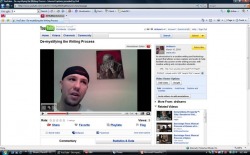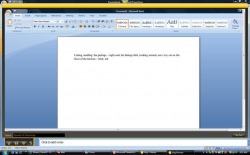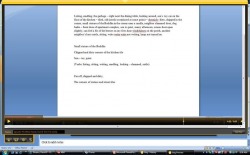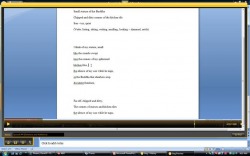|
|||||||||
|
|
De-mystifying the Writing Process

More aptly titled “De-mystifying One Writer’s Process,” this short multimodal video provides an introduction for the impetus behind this experiment (Robert Olen Butler’s “Inside Creative Writing”) and describes how I intend to map-out the writing process as outlined by Donald Murray (prewriting, writing, and rewriting) utilizing the screen-capture program Jing. Not only does the video set-up the experiment, but it also alludes to how the use of technology might facilitate class discussion, dispel the mythology and lore surrounding the writing process, and also attempt to build a bridge between composition theory and creative writing pedagogy. You can view the video on YouTube by clicking the screenshot above, or simply by clicking here. Episode #1 (Prewriting)

After reading a prompt from the website “Language is a Virus,” I sat down and embarked on the prewriting phase of my poem. I was intimated by the blank page, as I always am, but I started making a list of things I observed in my apartment, also making note of various sensory details. At one point, I became stuck and began freewriting in much the same way that Peter Elbow describes in Writing Without Teachers; essentially, to “just write whatever words [came] out” (9) in the hope that I could use it later. Interestingly, I had several misspellings throughout this process, one of which would lead me down an interesting metaphoric path. Episode #2 (The First Lines)

This episode chronicles the transition between the prewriting phase and the writing phase as I made notes of what intrigued me from my listing exercise and then I began writing the first lines of the poem. I found it interesting that I referenced my previous training in creative writing and how I have the tendency to begin many of my poems “in media res,” or in the middle of action (which, interestingly, is not the case when I write academic prose). Based on my experiences in previous workshops, I made a value judgment of beginning the poem using an “-ing” verb (i.e. that it was bad) and choose a different opening. Lastly, when I attempted to write, I felt extremely apprehensive and uncomfortable, primarily because I knew people (eventually) would be watching. Episode #3 (Crafting the First Stanza)

Even though I was still ensconced in the writing phase of the experiment, I began a little bit of rewriting or revision as well, keeping certain lines and demolishing others. Consequently, this coincides with Nancy Sommers assertion that writing and revision are recursive processes and that more experienced writers rewrite as they write (52). I also deviated from the premise of the experiment somewhat and went silent for a few moments, re-reading the text and thinking about how I could unpack some of the language to perhaps formulate a metaphor (which is indicative of my actual writing process). I attribute my momentary silences partially to some of the apprehension I was feeling with both the technology and the notion of being vulnerable to an audience, but also to the fact that I was struggling with hearing my voice in conjunction with thinking about what I was writing. Episode #4 (Deletions and Additions)

In many regards, this episode is a thematic continuation of Episode #3, since I constantly write and rewrite lines of the poem, but there’s a twist. While composing I read the text aloud several times to hear the rhythm, tone, and alliterative qualities of the language, but by reading aloud and talking through my thought-process I also began to generate new ideas or directions for the poem. In essence, I had re-entered the prewriting phase of my process; this should come as no surprise considering scholars such as Janet Emig have noted “…that for some of us, talking is a valuable, even necessary, form of pre-writing” (8). This episode, perhaps more than any other, truly reaffirms the recursive relationship between prewriting, writing, and rewriting. |
||||||||
|
|
|||||||||

